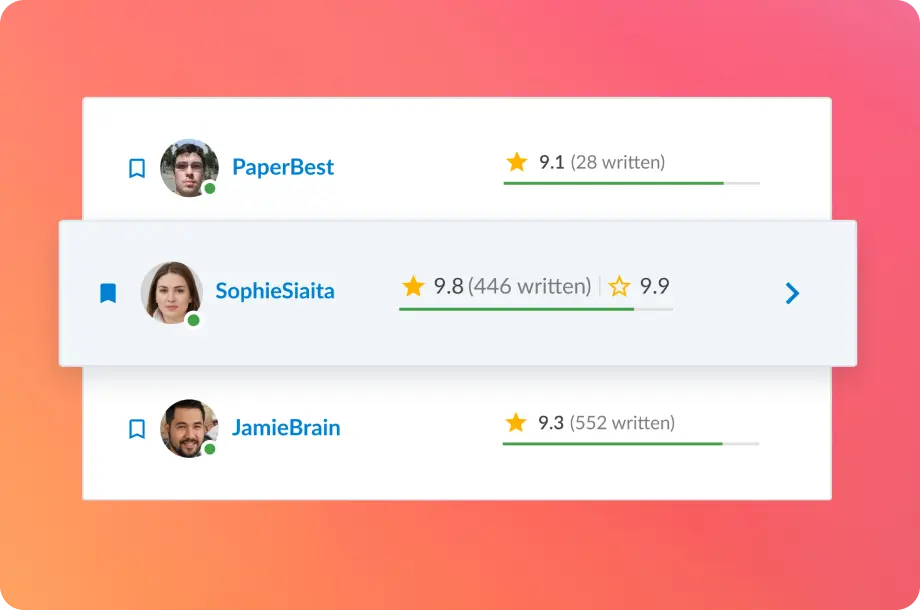If you need customized writing help, our experts are ready to assist you.
Protected with
We are sure that every customer will appreciate the features that we offer them


Our team of writers contains helpers who know how to write lab reports correctly.
Leave all of your instructions in the order form, and the expert will follow them.
All students who buy lab reports online here pay for finished pieces that satisfy them.
You have the opportunity to contact the writer directly to ask questions about the order.
We show our customers that using our service is absolutely secure and anonymous.
Check the finished lab report for plagiarism and AI for free on our website.
We offer our writing help at reasonable prices, starting from $12.70 per page. The cost depends on the requirements that you set in the order form.
$19.99
$6.99
$9.99
$9.99
$29.99
$16.99
We have 200+ writers who are ready to solve your writing problem quickly
We ask our customers to only leave honest opinions about our work
The proven authors from our lab report writing service are engaged in writing all types of lab reports in both exact and humanities-based disciplines. They will do all the necessary calculations, research, and drawings. When preparing your laboratory report, the writer will thoroughly analyze the methodological recommendations and requirements and consider your wishes. You will receive a high-quality and unique report that will deeply reveal the research topic and qualify for a high rating. By ordering a project from us, you will save time.
We guarantee:
Students often must finish writing a lab report, but they are stuck at the “needs to be done” stage. Don’t let it get to you; you will still have to do it at the last moment with the “leave me alone” mood. It doesn’t need to be like that. A laboratory report, although not as important as coursework, still affects your grades. EssayShark is one of the best lab report writing services, and you can leave your project and be sure that a professional writer will work on it.
In our humble opinion, it is better to ask us, “Write my lab report for me,” than to struggle with writing on your own. You will receive a custom project in any subject that you set, like chemistry, physics, biology, engineering, etc. Ordering lab reports online on our website is the key to success at college or university.
You should always approach choosing a performer responsibly so as not to tear your hair out later. Unfortunately, not all freelancers and companies work honestly; not every contractor fulfills the order on time, and even more so, does not provide any guarantees. We have created such conditions of cooperation that will protect both parties – the student and the author.
What does our lab report writing service offer?
Ordering any paper begins with filling out a form for our fast lab report writing service. For convenience, we have convenient order forms on each page. Therefore, you only need to go up a little and enter your data. Be sure to indicate all of your requirements. Fill in the following fields: subject, type of paper, topic of work, number of pages, deadline, etc.
Our cooperation can be divided into four stages:
If you are looking for someone to help you with your project, consider EssayShark.com. Buying a lab report from our service means you can forget your writing problem. Feel free to contact us anytime because we work round the clock. Our site is one of the writing services that care about its customers and try to satisfy their needs. Where do writers deliver high-quality papers? Here at EssayShark! Where are writers not afraid of deadlines? Here at EssayShark! If you want to buy a lab report, contact EssayShark! We will lift your spirits by providing you with professional writing help.
Many students have difficulty completing laboratory reports, which can negatively affect their performance. They come to us for well-formatted papers. A lab report writer will format your project correctly if you order it on our site.
If you ask us, “Write my lab report title page,” but don’t want to share your personal information, a writer can deliver a template with empty fields where you should put your data. By the way, we format title pages for our clients for free.
Yes, the shortest deadline we have is 4 hours. You can use it if you’re in a rush. You can also inform our writers that you’re in a hurry, and they can try to finish your order faster. However, we kindly advise you not to rely on such an ability.
It depends on the size of your order and the deadline you choose. The longer the deadline and the bigger the order, the higher the price. You can use the price list on our website to see what will be the price per page for the order with your academic level.
Yes, you don’t break any law when you use our help. Our service works according to the official rules and provides high-quality examples to the people who need them. There’s nothing illegal about that. We use credible payment systems and have policies according to which we work.
Yes, we have a team of professional helpers who can assist you with any kind of lab report. After you place an order, you’ll see the specialists who’ll bid for your order. You can choose the best one among them to help you with your lab report.

Disclaimer